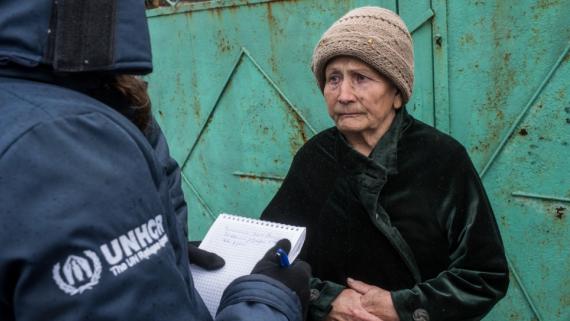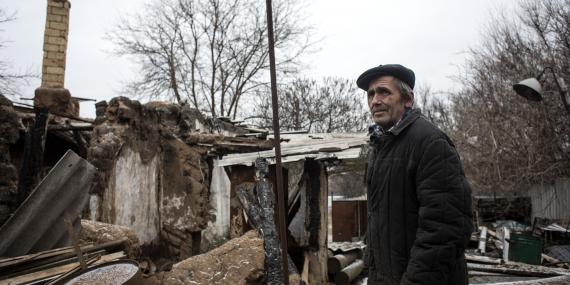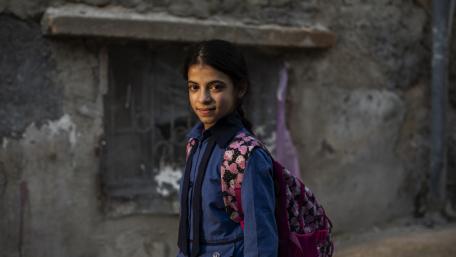Avdiivka, Ukraine
A local citizen of Avdiivka, Donetsk area, stands next to his home, which was shelled. UNHCR/Anastasia Vlasova
Humanitarian needs arising from the armed conflict in eastern Ukraine remain critical – even more so due to the unprecedented effects of COVID-19. Despite a drop in civilian casualties after the 27 July ceasefire and additional steps towards peace, there is no end in sight to hostilities.
The prevailing absence of a political solution continues to bring uncertainty and challenges to millions of people on both sides of the 427 km ‘contact line’ dividing the Donbas region into areas under the Government’s control (GCA) and those outside it (NGCA). Since 2014, this divide has severed previously interdependent networks of services and markets and cut people off from the cities upon which they depended for social benefits and essential services. The ‘contact line’ has also widened the rift between the people of GCA and NGCA
Ukraine
Analysis of the context, crisis and needs
The conflict has plunged an already economically troubled region into ruin. The shock of COVID-19 has added pressure on the weakened health-care system, the provision of social services and the struggling regional economy. During the first months of the pandemic, all crossing points along the ‘contact line’ were completely sealed off in an attempt to contain the virus, which seriously restricted people’s freedom of movement. This has further separated NGCA residents from the rest of Ukraine, cutting them off from social services and entitlements, including pensions. Two of the five crossing points partially reopened in June, but crossing procedures remain complicated. In 2020, the number of monthly crossings has been less than 10 per cent of the 1.2 million monthly crossings in 2019. The volume of humanitarian aid to NGCA dropped by 14 per cent between March and October 2020. The pandemic has made hundreds of thousands of conflict-weary people more vulnerable and even more dependent on humanitarian assistance.

Luhanske, Ukraine
A UNHCR worker writes down this 82-year-old woman's winter fuel needs in the village of Luhanske, Donetsk. As Ukraine enters the coldest months of January and February, when temperatures often fall below minus 20 degrees Celsius, winterization support for eastern Ukraine is not adequate to help vulnerable residents cope with the conditions caused by the conflict. A handful of older people who stayed behind struggle to keep warm in the harsh winter after conflict drove out younger residents.
UNHCR/Evgeny MaloletkaWith simmering hostilities and COVID-19 exacerbating the dire humanitarian situation in eastern Ukraine, the needs remain similar in scale, albeit significantly higher in severity, with 3.4 million people in need of humanitarian assistance in 2021. The elderly, people with disabilities, female-headed households and children are among the most vulnerable, as are the 340,000 IDPs living in undignified conditions across the country.
Projected situation in 2021 and beyond
Despite the latest ceasefire, the armed conflict is likely to continue with low intensity in 2021. COVID-19 will continue to be a major factor worsening the epidemiological situation throughout the approaching winter until at least mid-2021. The situation in NGCA is expected to be more acute due to the limited capacities of hospitals and laboratories. Socioeconomic vulnerabilities of the people on both sides of the ‘contact line’ are likely to remain severe due to the cumulative impact of the conflict exacerbated by COVID-19.
Evolution of needs and requirements (2016 - 2021)
The ‘contact line’ is likely to remain substantially closed until next summer despite the potential opening of two new crossing points in Luhanska oblast. Humanitarian convoys to NGCA, particularly to Luhansk (NGCA), are likely to remain difficult as the only crossing point in the region (Stanytsia Luhanska) does not allow truck transport, and restrictions on convoy transits through Donetsk (NGCA) are still in place. On a positive note, gradual progress on new organizations gaining access to operate in NGCA is likely, especially for pandemic-related response.
With COVID-19 continuing to firmly grip the entire country, economic recovery in eastern Ukraine seems unlikely. Communities are expected to remain dependent on support to regain their self-sufficiency and recover from the effects of the prolonged crisis as well as the pandemic. Despite an increase in the Government’s engagement in humanitarian response in GCA, national emergency response and preparedness capacities are likely to be overwhelmed by increasing and more severe needs.
Response priorities in 2021
The 2021 response will continue to focus on saving lives, ensuring people’s access to basic services and strengthening protection to those affected by the conflict and COVID-19. Humanitarian actors will continue to support the Government and local authorities to strengthen service delivery and provide humanitarian response in areas under its control. This support recognizes the strong capacity, particularly of the regional and local authorities, to play this leadership role and the development opportunities that are present. In 2021, humanitarian partners aim to assist 1.9 million people (including 189,000 IDPs in GCA). This is similar to the response target of 2020, and it reflects response capacity, access restrictions and the development of COVID-19.
Humanitarian needs in Ukraine will be more severe in 2021
With ongoing hostilities and the COVID-19 pandemic exacerbating the dire humanitarian situation in eastern Ukraine, 3.4 million people are projected to be in need of humanitarian assistance in 2021. The video shows the humanitarian crisis in eastern Ukraine and how humanitarian actors plan to respond.
OCHA UkraineThe humanitarian response will require $168 million during 2021. The critical priority requirements for early funding have been identified to allow immediate implementation of urgent activities. They were selected with emphasis on quality humanitarian actions that (i) save lives, (ii) specifically address the urgent needs of the most vulnerable, (iii) target the areas of the most severe humanitarian needs, (iv) consider time criticality, taking into consideration seasonality and COVID-19-related factors; (v) consider the probability of immediate implementation, and (vi) are non-duplicative of, or complementary to, the responses by other actors.
Further reading
Source: OCHA
Source: Humanitarian Insight
Source: Financial Tracking Service





